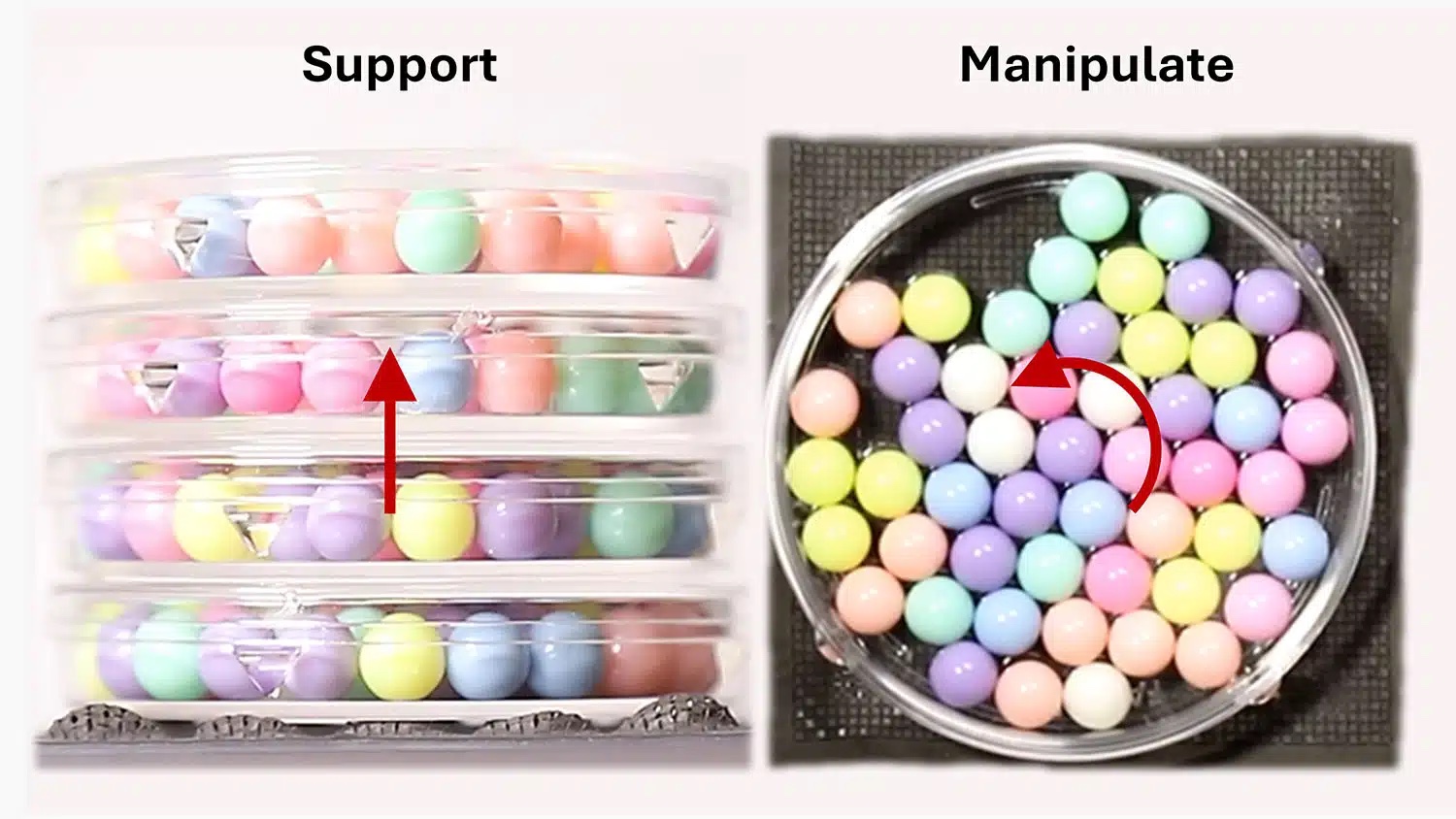Magnetically controlled kirigami surfaces move objects: no grasping needed

Researchers have developed a novel device that couples magnetic fields and kirigami design principles to remotely control the movement of a flexible dimpled surface, allowing it to manipulate objects without actually grasping them – making it useful for lifting and moving items such as fragile objects, gels or liquids. The technology has potential for use in confined spaces, where robotic arms or similar tools aren’t an option.
“We were trying to address two challenges here,” says Jie Yin, co-corresponding author of a paper on the work and an associate professor of mechanical and aerospace engineering at North Carolina State University. “The first challenge was how to move objects that you can’t pick up with grippers – such as fragile objects or things in confined spaces. The second challenge was how to use a magnetic field to remotely lift and move objects that are not magnetic.”
To address those challenges, the researchers created a “metasheet” that consists of an elastic polymer that is embedded with magnetic microparticles. A pattern was then cut into the sheet. The outer edges of the metasheet are attached to a rigid frame.
By moving a magnetic field under the metasheet, you can force sections of the metasheet to bulge upward or sink downward. Video of the metasheets in action can be found at https://www.youtube.com/watch?v=9dNNgZAidVk.
“You can actually cause the surface of the metasheet to move like a wave by controlling the direction of the magnetic field,” Yin says. “And adjusting the strength of the magnetic field determines how much the wave rise or fall.”
“Controlling the surface movement of the metasheet makes it possible to move many types of objects resting on the surface – whether they’re drops of liquid or a flat piece of glass,” says Joe Tracy, co-corresponding author of the paper and a professor of materials science and engineering at NC State.
“The design of cuts on the metasheet are an example of kirigami, or paper-cutting,” says Yinding Chi, first author of the paper and a former Ph.D. student at NC State. “This is particularly important for the metasheets, because kirigami enhances the flexibility without sacrificing the fundamental stiffness of the material itself.
“That allows us to amplify the deformation of the material without losing its mechanical strength,” says Chi, who is now a postdoctoral researcher at the University of Pennsylvania. “In addition, the metasheet is very responsive to the magnetic field, with a response time as fast as two milliseconds.”
“There’s been rather little work done on how magnetic actuation can be used in conjunction with kirigami, and what we’ve done here suggests that there’s a tremendous amount of potential for combining these approaches in fields from soft robotics to manufacturing applications,” says Tracy.
“We are interested in scaling this approach down, to allow the metasheets to manipulate smaller objects and smaller volumes of liquid,” says Chi.
“We’re also interested in how this approach could be used to create haptic technologies that may have applications in everything from gaming to accessibility devices,” says Yin.
The paper, “Magnetic kirigami dome metasheet with high deformability and stiffness for adaptive dynamic shape-shifting and multimodal manipulation,” is published in the journal Science Advances. The paper was co-authored by Matthew Clary, Fangjie Qi, Haoze Sun and Saarah Niesha Cantú of NC State; and by Emily Evans and Catherine Capodanno of Elon University.
This work was done with support from the National Science Foundation under grants 2005374, 2329674, 1663416 and 1662641.
-shipman-
Note to Editors: The study abstract follows.
“Magnetic kirigami dome metasheet with high deformability and stiffness for adaptive dynamic shape-shifting and multimodal manipulation”
Authors: Yinding Chi, Matthew R. Clary, Fangjie Qi, Haoze Sun, Saarah Niesha Cantú, Joseph B. Tracy and Jie Yin, North Carolina State University; Emily E. Evans and Catherine M. Capodanno, Elon University
Published: December 6, 2024, Science Advances
DOI: https://doi.org/10.1126/sciadv.adr8421
Abstract: Soft shape-shifting materials offer enhanced adaptability in shape-governed properties and functionalities. However, once morphed, they struggle to reprogram their shapes and simultaneously bear loads for fulfilling multifunctionalities. Here, we report a dynamic spatiotemporal shape-shifting kirigami dome metasheet with high deformability and stiffness that 2responds rapidly to dynamically changing magnetic fields. The magnetic kirigami dome exhibits over twice higher doming height and 1.5 times larger bending curvature, as well as sevenfold enhanced structural stiffness compared to its continuous counterpart without cuts. The metasheet achieves omnidirectional doming and multimodal translational and rotational wave-like shape-shifting, quickly responding to changing magnetic fields within 2 ms. Utilizing the dynamic shape-shifting and adaptive interactions with objects, we demonstrate its applications in voxelated dynamic displays and remote magnetic multimodal directional and rotary manipulation of nonmagnetic objects without grasping. It shows high-load transportation ability of over 40 times its own weight, as well as versatility in handling objects of different materials (liquid and solid), sizes, shapes, and weights.
This post was originally published in NC State News.
- Categories:


